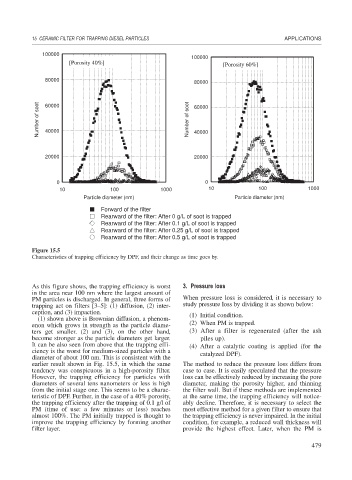Page 507 - Book Hosokawa Nanoparticle Technology Handbook
P. 507
15 CERAMIC FILTER FOR TRAPPING DIESEL PARTICLES APPLICATIONS
100000
100000
[Porosity 40%] [Porosity 60%]
80000
80000
Number of soot 60000 Number of soot 60000
40000
40000
20000 20000
0 0
10 100 1000 10 100 1000
Particle diameter (nm) Particle diameter (nm)
Forward of the filter
Rearward of the filter: After 0 g/L of soot is trapped
Rearward of the filter: After 0.1 g/L of soot is trapped
Rearward of the filter: After 0.25 g/L of soot is trapped
Rearward of the filter: After 0.5 g/L of soot is trapped
Figure 15.5
Characteristics of trapping efficiency by DPF, and their change as time goes by.
As this figure shows, the trapping efficiency is worst 3. Pressure loss
in the area near 100 nm where the largest amount of
PM particles is discharged. In general, three forms of When pressure loss is considered, it is necessary to
trapping act on filters [3–5]: (1) diffusion, (2) inter- study pressure loss by dividing it as shown below:
ception, and (3) impaction. (1) Initial condition.
(1) shown above is Brownian diffusion, a phenom-
enon which grows in strength as the particle diame- (2) When PM is trapped.
ters get smaller. (2) and (3), on the other hand, (3) After a filter is regenerated (after the ash
become stronger as the particle diameters get larger. piles up).
It can be also seen from above that the trapping effi- (4) After a catalytic coating is applied (for the
ciency is the worst for medium-sized particles with a catalyzed DPF).
diameter of about 100 nm. This is consistent with the
earlier result shown in Fig. 15.5, in which the same The method to reduce the pressure loss differs from
tendency was conspicuous in a high-porosity filter. case to case. It is easily speculated that the pressure
However, the trapping efficiency for particles with loss can be effectively reduced by increasing the pore
diameters of several tens nanometers or less is high diameter, making the porosity higher, and thinning
from the initial stage one. This seems to be a charac- the filter wall. But if these methods are implemented
teristic of DPF. Further, in the case of a 40% porosity, at the same time, the trapping efficiency will notice-
the trapping efficiency after the trapping of 0.1 g/l of ably decline. Therefore, it is necessary to select the
PM (time of use: a few minutes or less) reaches most effective method for a given filter to ensure that
almost 100%. The PM initially trapped is thought to the trapping efficiency is never impaired. In the initial
improve the trapping efficiency by forming another condition, for example, a reduced wall thickness will
filter layer. provide the highest effect. Later, when the PM is
479

